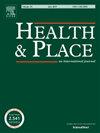Evaluating the protective effect of public open space on social connectedness: evidence from a natural experiment cohort study in three Canadian cities
IF 4.1
2区 医学
Q1 PUBLIC, ENVIRONMENTAL & OCCUPATIONAL HEALTH
引用次数: 0
Abstract
Community design has the potential to address urban isolation and loneliness at a population level, but limited research on the causal effects of the built environment constrains evidence-based action in cities. This study examined the effect of public open space on changes in social connectedness among adults (n = 665) during the COVID-19 pandemic, using geospatial data from OpenStreetMap and health survey data from three cities (Montréal, Saskatoon, and Vancouver). Treating the pandemic as a natural experiment, we used multilevel models to analyze whether public open space exposure (defined as the ratio of land area within 500m of home) modified changes in community belonging, loneliness, and neighbouring from 2018 to 2020/2021. First, we found little evidence of changes in social connectedness in our cohort overall and within subgroups. On average, loneliness increased slightly, and belonging and neighbouring remained stable. Second, we found that higher public open space exposure (≥10 % neighbourhood land area) had a modest protective effect on community belonging only (0.14, 95 % CI = 0.01 to 0.27). These findings add to a limited but growing evidence base on the role of the built environment in shaping social connectedness, while highlighting challenges involved in examining causal impacts. As cities invest in public open space to support policy goals around sustainability and livability, evaluating co-benefits for social connectedness are critical opportunities for strengthening the evidence on built environment solutions to social isolation and loneliness.
评估公共开放空间对社会联系的保护作用:来自加拿大三个城市的自然实验队列研究的证据
社区设计有可能在人口层面上解决城市隔离和孤独问题,但对建筑环境因果关系的研究有限,限制了城市中基于证据的行动。本研究使用OpenStreetMap的地理空间数据和来自三个城市(蒙塔姆萨、萨斯卡通和温哥华)的健康调查数据,研究了2019冠状病毒病大流行期间公共开放空间对成年人(n = 665)社会联系变化的影响。将大流行视为自然实验,我们使用多层模型分析2018年至2020/2021年期间,公共开放空间暴露(定义为住宅500米内土地面积的比例)是否改变了社区归属感、孤独感和邻里关系的变化。首先,我们发现几乎没有证据表明我们的整个群体和子群体中的社会联系发生了变化。平均而言,孤独感略有增加,归属感和邻居关系保持稳定。其次,我们发现较高的公共开放空间暴露(≥10%的邻里土地面积)仅对社区归属感有适度的保护作用(0.14,95% CI = 0.01至0.27)。这些发现为建筑环境在塑造社会联系方面的作用提供了有限但不断增长的证据,同时强调了研究因果影响所涉及的挑战。随着城市投资于公共开放空间,以支持围绕可持续性和宜居性的政策目标,评估社会连通性的共同效益是加强建筑环境解决社会隔离和孤独问题的证据的关键机会。
本文章由计算机程序翻译,如有差异,请以英文原文为准。
求助全文
约1分钟内获得全文
求助全文
来源期刊

Health & Place
PUBLIC, ENVIRONMENTAL & OCCUPATIONAL HEALTH-
CiteScore
7.70
自引率
6.20%
发文量
176
审稿时长
29 days
期刊介绍:
he journal is an interdisciplinary journal dedicated to the study of all aspects of health and health care in which place or location matters.
 求助内容:
求助内容: 应助结果提醒方式:
应助结果提醒方式:


